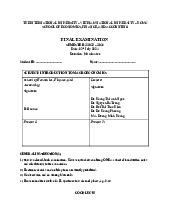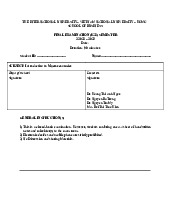









Preview text:
lOMoAR cPSD| 58504431 Prepared by Trinh Ngoc Nhan Chap 30
-P = the price level (e.g., the CPI or GDP deflator). P is the price of a basket of goods, measured in money.
-Supply of the money: In real world, determined by Federal Reserve, the banking system, consumers.
-Demand for the money: Refers to how much wealth people want to hold in liquid form.
+ Depends on P: An increase in P reduces the value of money, so more money is required to buy
g&s. Thus, quantity of money demanded is negatively related to the value of money and positively
related to P
▪ Nominal variables are measured in monetary units.
▪ Real variables are measured in physical units.
The Velocity of Money (độ xoay vòng của tiền)
▪ Velocity of money: the rate at which money changes hands lOMoAR cPSD| 58504431 Prepared by Trinh Ngoc Nhan
P x Y = nominal GDP = (price level) x (real GDP) M = money supply V = velocity
-The revenue from printing money is the inflation tax: printing money causes inflation, which is like
a tax on everyone who holds money.
▪ The real interest rate is determined by saving & investment in the loanable funds market.
▪ Money supply growth determines inflation rate.
▪ So, this equation shows how the nominal interest rate is determined. Chap 31
▪ A closed economy does not interact with other economies in the world.
▪ An open economy interacts freely with other economies around the world.
-Net exports (NX), as known as the trade balance. NX= value of exports – value of imports
-NX can be influenced by: Consumers’ preferences for foreign and domestic goods; Prices of goods
at home and abroad; Incomes of consumers at home and abroad; The exchange rates at which foreign
currency trades for domestic currency; Transportation costs; Govt policies, …
▪ Trade deficit: an excess of imports over exports (NX<0, E)
▪ Trade surplus: an excess of exports over imports (NX>0, E>I, Saving increase)
▪ Balanced trade: when exports = imports (NX=0, E=I) lOMoAR cPSD| 58504431 Prepared by Trinh Ngoc Nhan
THE FLOW OF THE CAPITAL
-Net capital outflow (NCO): domestic residents’ purchases of foreign assets minus foreigners’
purchases of domestic assets. NCO is also called net foreign investment.
▪ Foreign direct investment: Domestic residents actively manage the foreign
investment, e.g., McDonalds opens a fast-food outlet in Moscow.
▪ Foreign portfolio investment: Domestic residents purchase foreign stocks or bonds,
supplying “loanable funds” to a foreign firm.
⇨ FDI vs FPI: FDI is better. Since investment has plan to invest by using the FDI =>
They want to stay longer in our country or in the “long-term” => better for the economy’s development.
-NCO measures the imbalance in a country’s trade in assets:
▪ When NCO > 0, “capital outflow” Domestic purchases of foreign assets exceed
foreign purchases of domestic assets.
▪ When NCO < 0, “capital inflow” Foreign purchases of domestic assets exceed
domestic purchases of foreign assets.
-When a foreigner purchases a good from the U.S., the foreigner pays with currency or assets, so
the U.S. acquires some foreign assets, causing NCO to rise.
-When a U.S. citizen buys foreign goods, the U.S. buyer pays with U.S. dollars or assets, so the
other country acquires U.S. assets, causing U.S. NCO to fall. THE EXCHANGE RATE
▪ Nominal exchange rate: the rate at which one country’s currency trades for another
▪ Appreciation (or “strengthening”): an increase in the value of a currency, as measured by the
amount of foreign currency it can buy (giá trị đồng tiền đang xét tăng) lOMoAR cPSD| 58504431 Prepared by Trinh Ngoc Nhan
▪ Depreciation (or “weakening”): a decrease in the value of a currency, as measured by the
amount of foreign currency it can buy (giá trị đồng tiền đang xét giảm)
Ex: Nếu 1 USD= 100VND
● Depreciate: 1USD= 90VND, Dollar Mỹ bị “mất giá”
● Appreciate: 1USD= 120VND Dollar Mỹ “tăng giá”
- Depreciate sẽ tốt hơn cho EXPORT. Appreciate tốt hơn cho IMPORT
-Law of one price: the notion that a good should sell for the same price in all markets -Purchasing-
power parity: (PPP) a theory of exchange rates whereby a unit of any currency should
be able to buy the same quantity of goods in all countries Chap 32 lOMoAR cPSD| 58504431 Prepared by Trinh Ngoc Nhan
-E (Real Exchange rate) is the real value of a dollar in the market for foreign-currency exchange.
-If Exchange rate increase (decrease) => our currency will be appreciated (depreciated). lOMoAR cPSD| 58504431 Prepared by Trinh Ngoc Nhan
The Effects of a Budget Deficit ▪ National saving falls
▪ The real interest rate rises
▪ Domestic investment and net capital outflow both fall
▪ The real exchange rate appreciates (import> export => NCO decrease, real interest increase)
▪ Net exports fall (or, the trade deficit increases) CHAP 33
-Aggregate Demand (Tổng cầu) and Aggregate Supply lOMoAR cPSD| 58504431 Prepared by Trinh Ngoc Nhan
AD dịch chuyển vì:
▪ Changes in C
- Stock market boom/crash
- Preferences re: consumption/saving tradeoff - Tax hikes/cuts
▪ Changes in I
- Firms buy new computers, equipment, factories
- Expectations, optimism/pessimism
- Interest rates, monetary policy lOMoAR cPSD| 58504431 Prepared by Trinh Ngoc Nhan
- Investment Tax Credit or other tax incentives
▪ Changes in G
- Federal spending, e.g., defense
- State & local spending, e.g., roads, schools
▪ Changes in NX
- Booms/recessions in countries that buy our exports.
- Appreciation/depreciation resulting from international speculation in foreign exchange market b)
Three Facts About Economic Fluctuations FACT 1:
Economic fluctuations are irregular and unpredictable. FACT 2:
Most macroeconomic quantities fluctuate together. FACT 3:
As output falls, unemployment rises. CHAP 34:
▪ Recall, the AD curve slopes downward for three reasons:
▪ The wealth effect (Hiệu ứng của cải)
▪ The interest-rate effect (Hiệu ứng lãi suất) => QUAN TRỌNG NHẤT
Khi Price tăng, chúng ta cần thêm tiền để mua các loại hàng hóa => không có đủ tiền
để gửi vào ngân hàng => cung tiền giảm => Interest rate tăng => firm spend less than before.
▪ The exchange-rate effect (Hiệu ứng tỉ giá hối đoái)
Khi Price tăng => Interest rate tăng => NCO và exchange rate giảm => Không tốt cho
export => demand for the export giảm => Aggregate demand giảm. lOMoAR cPSD| 58504431 Prepared by Trinh Ngoc Nhan
▪ Next: A supply-demand model that helps explain the interest-rate effect and how monetary
policy affects aggregate demand.
▪ The variables that influence money demand: Y, r, and P. r is the opportunity cost of money supply.
An increase in r causes a decrease in money demand, other things equal
An increase in P causes an increase in money demand, other things equal.
▪ Fiscal policy: the setting of the level of govt spending and taxation by govt policymakers
+ Expansionary fiscal policy
▪ an increase in G and/or decrease in T ▪ shifts AD right
+ Contractionary fiscal policy
▪ a decrease in G and/or increase in T ▪ shifts AD left
Multiplier effect: the additional shifts in AD that result when fiscal policy increases income and
thereby increases consumer spending lOMoAR cPSD| 58504431 Prepared by Trinh Ngoc Nhan Chap 35



